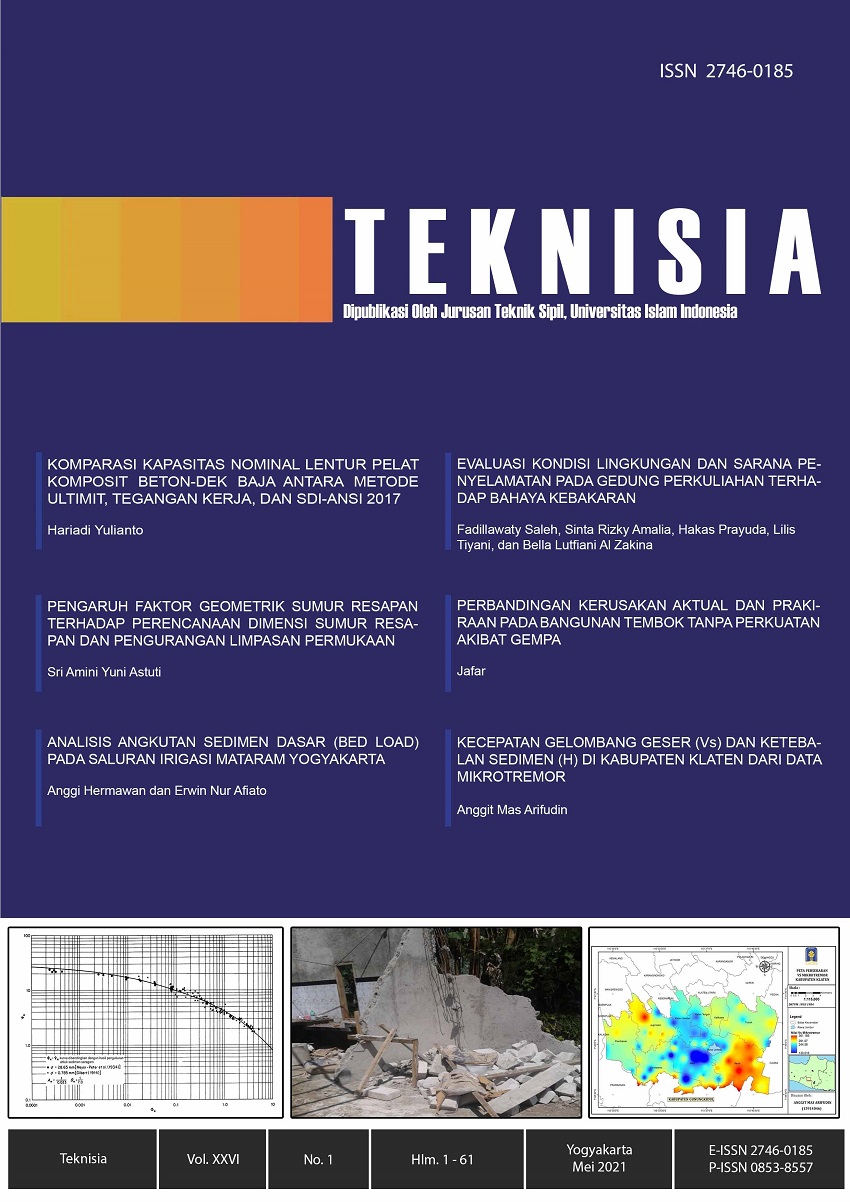Main Article Content
Abstract
Keywords
Article Details
Under the following term:
-
Attribution — You must give appropriate credit, provide a link to the license, and indicate if changes were made. You may do so in any reasonable manner, but not in any way that suggests the licensor endorses you or your use.
-
ShareAlike — If you remix, transform, or build upon the material, you must distribute your contributions under the same license as the original.
- No additional restrictions — You may not apply legal terms or technological measures that legally restrict others from doing anything the license permits.
References
- Aswandono, B. (2011). "Building Replacement Cost for Seismic Risk Assessment in Palbapang Village, Bantul Sub-District, Yogyakarta Building Replacement Cost For Seismic Risk Assessment in Palbapang, Indonesia". Universitas Gadjah Mada.
- Bawono, A. S. (2011). "Kajian Bangunan Di Indonesia Dengan Amerika (Studi Kasus Rumah Di Bantul)". Inersia, 7(1), 85–95.
- Bawono, A. S. (2016). "Studi Kerentanan Bangunan Akibat Gempa Studi Kasus Perumahan Di Bantul". Semesta Teknika, 19(1), 90–97.
- BMKG. (2018). "Press Release Gempabumi Banjarnegara, M 4.4, Rabu 18 April 2018, 13:28:38 WIB". https://cdn.bmkg.go.id/web/PRESS-RELEASE_Banjarnegara_-18-April-1-2018.pdf.
- Douglas, J. (2018). "Ground motion prediction equations 1964-2018". Departmen of Civil and Environmental Engineering, University of Stratchlyde.
- Erlangga, W. (2020). "Karakteristik Dan Parameter Subduksi Sumber Gempa Pulau Jawa". Teknisia, XXV(2), 30–40.
- FEMA. (2004). "Using HAZUS-MH for Risk Assessment". (Issue August).
- FEMA. (2005). "Improvement of Nonlinear Static Seismic Analysis Procedures. In FEMA 440, Federal Emergency Management Agency, Washington DC". (Vol. 440, Issue June).
- FEMA. (2020). "HAZUS. Earthquake Model, Technical Manual". Federal Emergency Management Agency, Washington DC., October. https://www.fema.gov/
- Gulati, B. (2006). "Earthquake Risk Assessment of Buildings: Applicability of HAZUS in Dehradun, India".
- Hancilar, U., Sesetyan, K., & Cakti, E. (2020). "Comparative earthquake loss estimations for high-code buildings in Istanbul". Soil Dynamics and Earthquake Engineering, 129 (May 2019), 105956. https://doi.org/10.1016/j.soildyn.2019.105956
- Handika, M. S. D., & Madlazim (2020). No Title. Jurnal Inovasi Fisika Indonesia (IFI), 09(03), 1–6.
- IFRC. (2015). "Sendai Framework for DRR". March, 25. http://www.unisdr.org/we/inform/terminology
- Khalfan, M., Tait, M. J., & El-Dakhakhni, W. W. (2012). "Proposed Technique for Seismic Vulnerability Evaluation of Single Storey Unreinforced Masonry Residential Buildings in Developing Countries". 15th International Brick and Block Masonry Conference, 10.
- Li, J., & Weigel, T. A. (2006). "Damage States for Reinforced CMU Masonry Shear Walls". Advances in Engineering Structures, Mechanics & Construction (pp. 111–120). Springer.
- Neighbors, C. J., Cochran, E. S., Caras, Y., & Noriega, G. R. (2013). "Sensitivity Analysis of FEMA HAZUS Earthquake Model: Case Study from King County, Washington". Natural Hazards Review, 14(2), 134–146. https://doi.org/10.1061/(asce)nh.1527-6996.0000089
- Pratiwi, D. S., Teguh, M., & Pawirodikromo, W. (2019). "An Implementation of the HAZUS Method for Estimating Potential Damage of Residential Houses at Pacitan Sub-district, East Java, Indonesia due to Earthquake". MATEC Web of Conferences, 280, 01008. https://doi.org/10.1051/matecconf/201928001008
- Saputra, E., & Faizah, R. (2019). "Kajian Kerusakan Bangunan Sederhana Pasca Gempa Banjarnegara 18 April 2018". Agregat, 4(1). https://doi.org/10.30651/ag.v4i1.2816
- Spence, R. (2004). "Earthquake protection: the need for legislation to strengthen high-risk buildings". 13th World Conference on Earthquake Engineering, 2082.
- Tantala, M. W., Nordenson, G. J. P., Deodatis, G., & Jacob, K. (2008). "Earthquake loss estimation for the New York City Metropolitan Region". Soil Dynamics and Earthquake Engineering, 28(10–11), 812–835. https://doi.org/10.1016/j.soildyn.2007.10.012
- Widodo. (2012). "Seismologi Teknik dan Rekayasa Kegempaan". Pustaka Pelajar.
References
Aswandono, B. (2011). "Building Replacement Cost for Seismic Risk Assessment in Palbapang Village, Bantul Sub-District, Yogyakarta Building Replacement Cost For Seismic Risk Assessment in Palbapang, Indonesia". Universitas Gadjah Mada.
Bawono, A. S. (2011). "Kajian Bangunan Di Indonesia Dengan Amerika (Studi Kasus Rumah Di Bantul)". Inersia, 7(1), 85–95.
Bawono, A. S. (2016). "Studi Kerentanan Bangunan Akibat Gempa Studi Kasus Perumahan Di Bantul". Semesta Teknika, 19(1), 90–97.
BMKG. (2018). "Press Release Gempabumi Banjarnegara, M 4.4, Rabu 18 April 2018, 13:28:38 WIB". https://cdn.bmkg.go.id/web/PRESS-RELEASE_Banjarnegara_-18-April-1-2018.pdf.
Douglas, J. (2018). "Ground motion prediction equations 1964-2018". Departmen of Civil and Environmental Engineering, University of Stratchlyde.
Erlangga, W. (2020). "Karakteristik Dan Parameter Subduksi Sumber Gempa Pulau Jawa". Teknisia, XXV(2), 30–40.
FEMA. (2004). "Using HAZUS-MH for Risk Assessment". (Issue August).
FEMA. (2005). "Improvement of Nonlinear Static Seismic Analysis Procedures. In FEMA 440, Federal Emergency Management Agency, Washington DC". (Vol. 440, Issue June).
FEMA. (2020). "HAZUS. Earthquake Model, Technical Manual". Federal Emergency Management Agency, Washington DC., October. https://www.fema.gov/
Gulati, B. (2006). "Earthquake Risk Assessment of Buildings: Applicability of HAZUS in Dehradun, India".
Hancilar, U., Sesetyan, K., & Cakti, E. (2020). "Comparative earthquake loss estimations for high-code buildings in Istanbul". Soil Dynamics and Earthquake Engineering, 129 (May 2019), 105956. https://doi.org/10.1016/j.soildyn.2019.105956
Handika, M. S. D., & Madlazim (2020). No Title. Jurnal Inovasi Fisika Indonesia (IFI), 09(03), 1–6.
IFRC. (2015). "Sendai Framework for DRR". March, 25. http://www.unisdr.org/we/inform/terminology
Khalfan, M., Tait, M. J., & El-Dakhakhni, W. W. (2012). "Proposed Technique for Seismic Vulnerability Evaluation of Single Storey Unreinforced Masonry Residential Buildings in Developing Countries". 15th International Brick and Block Masonry Conference, 10.
Li, J., & Weigel, T. A. (2006). "Damage States for Reinforced CMU Masonry Shear Walls". Advances in Engineering Structures, Mechanics & Construction (pp. 111–120). Springer.
Neighbors, C. J., Cochran, E. S., Caras, Y., & Noriega, G. R. (2013). "Sensitivity Analysis of FEMA HAZUS Earthquake Model: Case Study from King County, Washington". Natural Hazards Review, 14(2), 134–146. https://doi.org/10.1061/(asce)nh.1527-6996.0000089
Pratiwi, D. S., Teguh, M., & Pawirodikromo, W. (2019). "An Implementation of the HAZUS Method for Estimating Potential Damage of Residential Houses at Pacitan Sub-district, East Java, Indonesia due to Earthquake". MATEC Web of Conferences, 280, 01008. https://doi.org/10.1051/matecconf/201928001008
Saputra, E., & Faizah, R. (2019). "Kajian Kerusakan Bangunan Sederhana Pasca Gempa Banjarnegara 18 April 2018". Agregat, 4(1). https://doi.org/10.30651/ag.v4i1.2816
Spence, R. (2004). "Earthquake protection: the need for legislation to strengthen high-risk buildings". 13th World Conference on Earthquake Engineering, 2082.
Tantala, M. W., Nordenson, G. J. P., Deodatis, G., & Jacob, K. (2008). "Earthquake loss estimation for the New York City Metropolitan Region". Soil Dynamics and Earthquake Engineering, 28(10–11), 812–835. https://doi.org/10.1016/j.soildyn.2007.10.012
Widodo. (2012). "Seismologi Teknik dan Rekayasa Kegempaan". Pustaka Pelajar.
